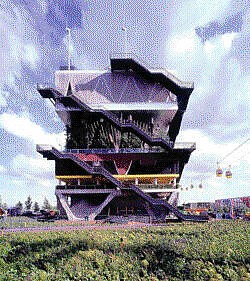2004.12.17 12:15
postpostmoderniam (arrgh)
Postmodernism (in architecture) literally began over 70 years ago with the reaction of the residents to Le Corbusier's Pessac housing.
A serious study of what buildings were under construction in 1950s Rome while Venturi was at the American Academy (e.g., Luigi Moretti's apartments on the Via Parioli) will add much to an understanding of the early genesis of 'postmodernism' as a distinct design methodology.
2005.03.01 13:08
Re: thoughts on body art....
Although I've never read the text myself, I'm pretty sure Adolf Loos in "Ornament Is Crime" has a lot of negative things to say about 'primitive' tattoos. This text became somewhat seminal with regard to the Modern Movement in architecture, and can be seen as precursor of the purist aesthetic of Esprit Nouveau (which later got sort of rehashed as The International Style).
Is "From White Cube to Tattooed Cube" yet to be written?
2005.03.28 12:25
Re: R...
The notion of reenacting the Trilon and Perisphere of the 1939-40 New York World's Fair is only virtual architecture at best. Nonetheless, I find it evocative of how 'design' could be handled, as in Brian's recognition of the archaeological.
Interesting how the Parthenon was destroyed by explosion--the building was used by the Turks as an ammunition magazine, and a stray spark during a battle ignited the sitting bomb. "And now it's a prosperous tourist destination."
2005.04.01 14:55
how should someone feel after visiting a museum?
If it's an exceptional avant-garde museum, then according to design appropriateness, and even according to 'sustainable design' standards, the visitor should feel sucked in, confused, inadequate and, of course, an aftershock of wanting more.
2005.04.03 16:57
Fashion Trends
There's really only one trend, and that's planned obsolescence.
2005.04.11 09:22
figure/ground vs field condition
Can you explain why the (so-called) extraordinarily rigid figure/ground relationship outside the Museum of Contemporary Art needed compensating? What about the temporary exhibit was non-rigid? (That's 'non-rigid' speaking figuratively, since the exhibit structure comprised many rigid components. The notion of non-hierarchical also seems a figurative notion, since a temporary condition by definition falls within a hierarchy.)
Exactly what classical figure/ground compositions does the City of Culture in Santiago de Compestela design-as-commentary dissolve? To me, the design looks more like the rethinking of a typical US suburban mall. Suburban malls are more a field condition than a figure/ground composition, aren't they?
Eisenman's Holocaust Memorial is probably more a traditional figure/ground condition inserted into a site-specific inserted field condition, rather than the other way around. Berlin since the end of WWII was/is hardly a 'traditional' place anymore.
If field conditions are somehow non-hierarchical, why do I get the feeling that field conditions are seen (at least by those that design them) as somehow better than figure/ground compositions?
| |
2005.04.11 11:18
modernity/post-modernity
I'm not too sure that I would relate Le Corbusier and Kahn as the same type of 'International Style'.
South America does indeed appear to have much more 'International Style' architecture than North America.
Reread Loos because the whole anti-ornament issue stems from a critique of 'primitive' tattooing, which very much evokes 'colonialism thinking'.
2005.04.11 13:23
modernity/post-modernity
What is the universal truth that Modernity believes in?
What are some examples of relative truths?
[Isn't the notion that the world is "complex without objective truth" itself "a belief that there is some kind of objective universal truth?"]
So Postmodernity replaces Modernity's certainty of rationality with the certainty of relativity?
[Is "the ether" still the playground architectural theory plays in?]
What is more truthful, professional architectural photography or the candid snapshot of a building?
2005.04.11 14:57
modernity/post-modernity
Maybe it's just me, but I see professional architectural photographic akin to plastic surgery, a kind of makeover.
I like Sherman's work a lot, but I see it as reenactionary before anything else. [Reenactment works with degrees of separation, anything from getting as close to the original as possible, to stretching the truth as far as it will go.]
2005.04.11 15:07
Architecture displaying movement?
Aldo Rossi's Teatro del Mondo.
The original spiral columns at St. Peter's which came from Greece.
The Elgin Marbles.
The Japanese House in Fairmount Park, Philadelphia--from Japan to MoMA's courtyard to Philadelphia parkland.
The International Space Station.
Is it possible for any architecture to display movement if it stays in the same place all the time?
2005.04.11 15:38
Architecture displaying movement?
Quondam - A Virtual Museum of Architecture goes all over the planet. Sometimes it's even big in Japan.
2005.05.17 18:38
Sexual Architecture??
Paul Rudolph may indeed be the progenitor of sado-masochistic architecture.
| |
2005.05.24 09:20
nice urban housing in philadelphia
I don't think Philadelphia has any kind of monopoly on quotidian bricolage housing, but it might just have the longest running tradition of quotidian bricolage housing in the USA.
2005.06.23 11:22
original content
I think original content scares people. I think it especially scares people that want to be original themselves. For example, originality in design makes other designers feel inadequate, although mimesis is guaranteed to follow. There is also the guarantee that some will immediately steal the original content and then quickly try to somehow pass it off as their own.
2005.08.16 11:28
the agnostic design of spiritual space
I have some ideas about how to design sacred space, and they have to do with making it osmotic and electromagnetic. Some of Kahn's best architecture is osmotic and electromagnetic.
2005.08.23 13:28
Tiring architects VS Real Architects
The late period of artists is often under-rated. Picasso's Late Period was mostly disliked while he was alive--seen as repetitious and unimportant. Yet, with Picasso dead, the late works are not so unimportant anymore, in fact they manifest one of Picasso's most creative periods.
Frank Gehry may be in a wonderful position if he continues to do architecture for another decade or so, because, when he isn't around anymore, his late works might just manifest his most creative period.
I like to look at and study the late periods of artists because of all the facile-ness and confidence and even (if you're lucky) the "I don't give a damn" found there.
Philip Johnson produced an interesting late period, and he did change 'styles' with every new project, yet his overall style has always been reenactionary architecturism.
2005.08.23 16:30
AMO asks for your response
Can you say why publicity cannot be a foundation of architecture?
2005.09.08 10:54
are the origins common ? can we prove it ?
Do a thesis on the commonality of brainwashing within architectural education within say the last two to three decades. Brainwashing in the sense of becoming blind to what is otherwise self evident. For example, is the Villa Savoye really a house? Yes, it's design intention was for it to be a house, but that's not what it really turned out to be, is it?
| |
2005.09.08 12:04
are the origins common ? can we prove it ?
I was yesterday thinking of the Villa Savoye as a museum, perhaps specifically a museum of Modern architecture even?
What seems to be most common among creation/origin myths is indeed duality. The first paragraphs of Genesis, for example, are replete with dualities, and the notion of (generally good and evil) twins is found in creation/origin myths from all over the globe.
2005.09.08 16:18
Hadrian was born in Spain
Ludwig II's architecture is no doubt aesthetically over the top, but in terms of craftsmanship, it is all top notch. It is fair to say that Ludwig's architecture inspired a lot of kitsch. Reenactionary Architecturism addresses the disticntion between popular sentimentality and reenactionary architecturism, and Ludwig II's architecture is a main point in that distinction.
2005.09.09 12:08
AMO asks for your response
NOLA, the new Low Country, the new Nether Lands?
AMO as Dutch Treat?
SuperNOLA is next?
Yes, but what if the earth's water level will rise due to the greenhouse effect? What is the real future of the low countries?
2005.09.09 12:23
Hadrian was born in Spain
Interestingly, Giulio Carlo Argan was Mayor of Rome in the late 1970s. He was co-author of Michelangelo Architecto, and (I believe) instrumental in manifesting the project/exhibit Roma Interrotta.
Maybe Roma Interrotta is really just still going on.
2005.09.13 12:27
"design" vs. "styling"
It's probably true that fashion has always been more about style than design. The design of most clothes really hasn't changed all that much over the last century or so, but the style certainly has. Style is basically ephemeral.
Design gets bad when it also becomes ephemeral because that mostly also means that the real underlying design is then planned obsolescence.
2005.09.13 13:16
"design" vs. "styling"
ephemeral (adj)
1.Lasting for a markedly brief time.
2. Living or lasting only for a day, as certain plants or insects do.
ephemeral (noun)
1. A markedly short-lived thing
2005.09.13 13:39
"design" vs. "styling"
The muddy water clears up real quick for me as soon as I add 'ephemerality' to the mix.
It even helps in these muddy waters.

| |
2005.09.13 13:34
"design" vs. "styling"
It is not that something ephemeral cannot also be design, it is more that "Design gets bad when it also becomes ephemeral because that mostly also means that the real underlying design is then planned obsolescence."
The main reason I see ephemeral designs as not good designs is because the ephemeral things don't just disappear, but become trash. What is most commercial packaging, for example, if not ultimately highly designed trash. Plus that pavilion thingy recently/currently(?) at PS1--it didn't take very long at all for that to get trashy.
2005.09.13 17:05
"design" vs. "styling"
I'm more interested in the self evidence of it all. For example, I like the design of MVRDV's Dutch Pavilion, especially as presented in drawings and within the continuum of their oeuvre. I didn't so much like the Pavilion as built (at least from the images I've seen). And now there is no denying that the Dutch Pavilion is leftover trash, architecture that might be saved or that might be demolished. Overall (so far), the good reality of the design is outweighed by the bad reality of the design.
Is the Dutch Pavilion also stylized? It seems to be so in that a lot of it was also high-maintenance.
Will the design of the Dutch Pavilion ever be a true paradigm for future architecture? I'll say definitely maybe.
2005.09.14 13:40
"design" vs. "styling"
Style now-a-days is largely egalitarian. Almost everything produced today harbors some degree of style. Price (which is supposed to reflect quality) is really the only thing that differentiates styles.
Overall, Modern or contemporary architecture is not a very popular style for living in.
Big Boxes are very efficient designs with little or no style?
The more style added to architecture the higher the maintenance?
My personal style anymore defaults to "no class" offset by an enormous aversion to falsehood. It makes for an easier life due mostly to low maintenance requirements.
The design of my life, however, is very complicated because art is its ongoing goal.
2005.09.14 16:11
"design" vs. "styling"
So current-day stylization has a lot to do with covering-up or eliminating the common insecurities of most individuals?
2005.09.14 16:24
"design" vs. "styling"

Mario Bellini
1973
design and style
|